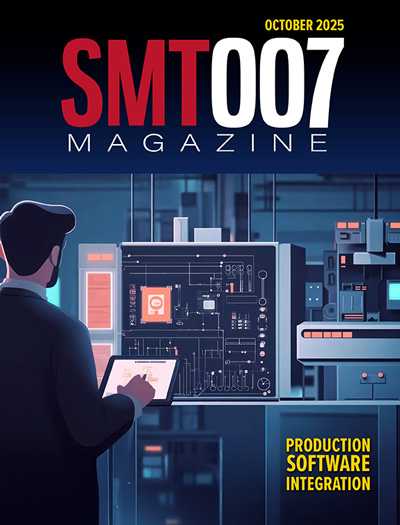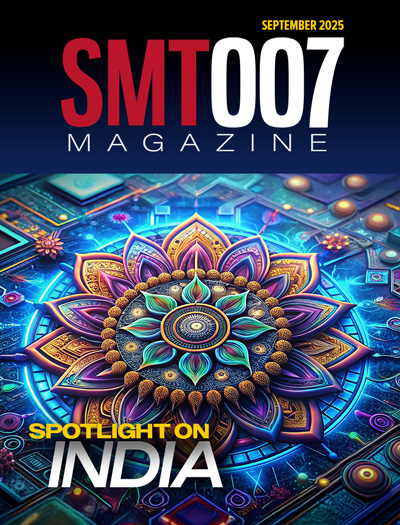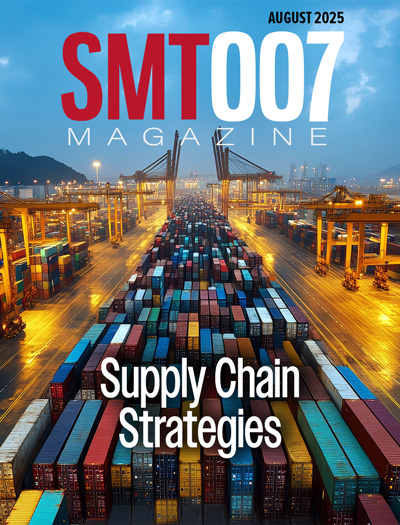-

-
News
News Highlights
- Books
Featured Books
- smt007 Magazine
Latest Issues
Current Issue
Production Software Integration
EMS companies need advanced software systems to thrive and compete. But these systems require significant effort to integrate and deploy. What is the reality, and how can we make it easier for everyone?

Spotlight on India
We invite you on a virtual tour of India’s thriving ecosystem, guided by the Global Electronics Association’s India office staff, who share their insights into the region’s growth and opportunities.

Supply Chain Strategies
A successful brand is built on strong customer relationships—anchored by a well-orchestrated supply chain at its core. This month, we look at how managing your supply chain directly influences customer perception.
- Articles
- Columns
- Links
- Media kit
||| MENU - smt007 Magazine
Size Matters: The Effects of Solder Powder Size on Solder Paste Performance
July 8, 2019 | Tony Lentz, FCT AssemblyEstimated reading time: 4 minutes
Abstract
Solder powder size is a popular topic in the electronics industry due to the continuing trend of miniaturization of electronics. The question commonly asked is, "When should we switch from Type 3 to a smaller solder powder?” Solder powder size is usually chosen based on the printing requirements for the solder paste. It is common practice to use IPC Type 4 or 5 solder powders for stencil designs that include area ratios below the recommended IPC limit of 0.66. The effects of solder powder size on the printability of solder paste have been well documented.
The size of the solder powder affects the performance of the solder paste in other ways. Shelf life, stencil life, reflow performance, voiding behavior, and reactivity/stability are all affected by solder powder size. Testing was conducted to measure each of these solder paste performance attributes for IPC Type 3, 4, 5, and 6 SAC305 solder powders in both water-soluble and no-clean solder pastes. The performance data for each size of solder powder in each solder paste flux was quantified and summarized. Guidance for choosing the optimal size of solder powder is given based on the results of this study.
Introduction
Size matters. That simple statement is true for many things in life. Small hands are better for speed texting. Large people are better at playing offensive or defensive line in the national football league. Antibodies are microscopically small but they play a key role in our health and wellbeing. Who doesn’t want a large cup of coffee (Figure 1)?
Figure 1: Size matters.
Size also matters in the world of solder paste. The size of the solder powder used in a solder paste has an effect on solder paste performance. Solder powder sizes are classified by type in the IPC standard J-STD-005 (requirements for soldering pastes) [1]. Table 3-2 details the solder powder size ranges for each type, and an excerpt is shown in Table 1.
The main particle size range is normally associated with the type. For example, Type 3 solder powder mainly falls within the 25–45 µm size range; therefore, Type 3 solder paste may be labeled as “Type 3 (25–45 µm).” Figure 2 shows Type 3, 4, 5, and 6 sizes of solder powder.
Table 1: Solder powder size (adapted from Table 3-2 of IPC J-STD-005A).
Why use Type 4, 5, or 6 solder powder rather than Type 3? The main reason to use smaller solder powders in solder paste is to improve the printability for miniature components. As solder powder size decreases, the solder pastes can be printed through smaller stencil apertures. If the “5-ball” rule is followed from the IPC-7525 stencil design guidelines standard [2], then the minimum aperture size through which printing can occur can be calculated for each solder powder size [3]. These calculations for minimum aperture size were performed using five times the maximum solder powder size of the main range (Table 2).
Figure 2: IPC Type 3, 4, 5, and 6 solder powders.
Generally speaking, Type 3 solder paste can be used for components ranging down to the 0402 imperial package size. Most solder paste users prefer Type 4 solder paste for 0201 imperial, micro BGAs, and similar components. Type 5 solder paste is used for even smaller soldering applications like 01005 imperial components [4] or when Type 4 solder paste does not print adequately. Type 5 and 6 solder pastes are used for dispensing applications, such as jet printing. Type 6 solder paste is also used for other ultra-fine-feature applications [5 & 6].
Table 2: Solder powder size and minimum stencil aperture size for printing using the 5-ball rule.
Aside from the printing capabilities given by smaller solder powders [7], other performance changes occur when smaller solder powders are used. Stencil and shelf life of the solder pastes may be shortened when using smaller solder powders. Smaller solder powders have a higher potential for random solder balling and graping. Voiding behavior can also be affected by a change in solder powder size. The goal of this study is to quantify the performance for IPC Type 3, 4, 5, and 6 SAC305 (Sn / Ag 3.0% / Cu 0.5%) solder powders in both water-soluble and no-clean solder pastes. Experimental data for each solder paste is compared and contrasted, and recommendations for the optimal use of each solder paste are given.
Methodology
Surface Area of Solder Powder and Reactivity
Table 3: Solder powder size and surface area for a 1 Kg mass.
As the solder powder size decreases, the surface area of solder powder increases for a given mass (Table 3) [8]. These surface areas were calculated using the middle value in the main particle size range.
The surface area of the solder powder is important because it plays a role in the reactivity of the solder powder. As the surface area increases, the rate of reaction increases. Imagine trying to dissolve a cube of sugar in a cup of water. It takes time and a lot of stirring for the sugar to dissolve completely. If the same mass of granular sugar is mixed into a cup of water, it dissolves much more quickly.
To read the full article, which appeared in the July 2019 issue of SMT007 Magazine, click here.
Testimonial
"The I-Connect007 team is outstanding—kind, responsive, and a true marketing partner. Their design team created fresh, eye-catching ads, and their editorial support polished our content to let our brand shine. Thank you all! "
Sweeney Ng - CEE PCBSuggested Items
Rehm Wins Mexico Technology Award for CondensoXLine with Formic Acid
10/17/2025 | Rehm Thermal SystemsModern electronics manufacturing requires technologies with high reliability. By using formic acid in convection, condensation, and contact soldering, Rehm Thermal Systems’ equipment ensures reliable, void-free solder joints — even when using flux-free solder pastes.
Indium Experts to Deliver Technical Presentations at SMTA International
10/14/2025 | Indium CorporationAs one of the leading materials providers to the power electronics assembly industry, Indium Corporation experts will share their technical insight on a wide range of innovative solder solutions at SMTA International (SMTAI), to be held October 19-23 in Rosemont, Illinois.
Knocking Down the Bone Pile: Revamp Your Components with BGA Reballing
10/14/2025 | Nash Bell -- Column: Knocking Down the Bone PileBall grid array (BGA) components evolved from pin grid array (PGA) devices, carrying over many of the same electrical benefits while introducing a more compact and efficient interconnect format. Instead of discrete leads, BGAs rely on solder balls on the underside of the package to connect to the PCB. In some advanced designs, solder balls are on both the PCB and the BGA package. In stacked configurations, such as package-on-package (PoP), these solder balls also interconnect multiple packages, enabling higher functionality in a smaller footprint.
Indium to Showcase High-Reliability Solder and Flux-Cored Wire Solutions at SMTA International
10/09/2025 | Indium CorporationAs one of the leading materials providers in the electronics industry, Indium Corporation® will feature its innovative, high-reliability solder and flux-cored wire products at SMTA International (SMTAI), to be held October 19-23 in Rosemont, Illinois.
‘Create your Connections’ – Rehm at productronica 2025 in Munich
10/08/2025 | Rehm Thermal SystemsThe electronics industry is undergoing dynamic transformation: smart production lines, sustainability, artificial intelligence, and sensor technologies dominate current discussions.


